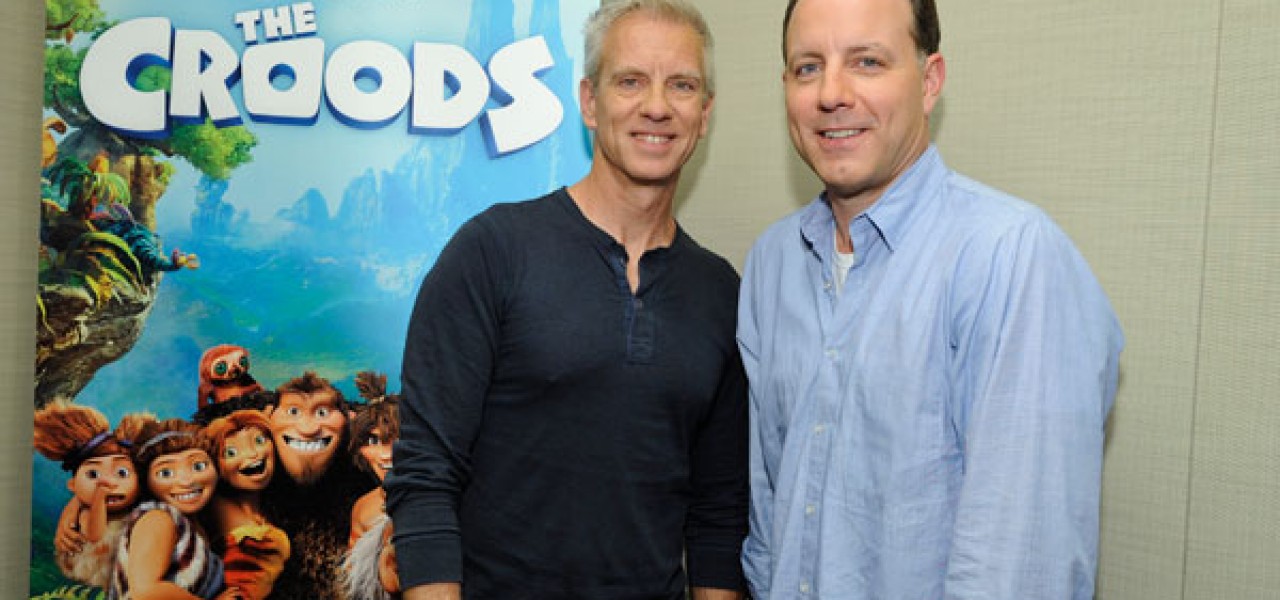
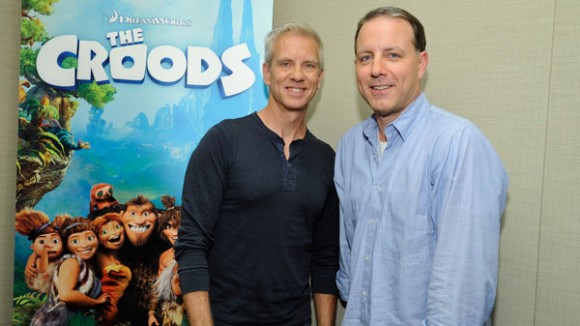
“Croods” Directors Kirk DeMicco and Chris Sanders on Making An Ensemble Film
When the server enters the drawing room of the Crosby Hotel, Kirk DeMicco’s eyes begin to dance. “Mini desserts are coming! Many, many mini desserts!” Both DeMicco (Racing Stripes, Space Chimps) and Chris Sanders (Lilo & Stitch, How to Train Your Dragon) are in New York to take part in a presentation on the making of The Croods, the animated film that they directed for Dreamworks earlier this year, which went on to gross nearly $600 million worldwide.
Taking a break from the Oscar race for best animated feature, they sat down with Cartoon Brew to marvel over the sweet potato crème brulee, chocolate cheesecake and pistachio plum cake… and of course, talk about how the film came to be.
“When we first started talking about this,” DeMicco begins, “Chris and I were saying we’re going to make the first Dreamworks film about a family.” The Croods, which features a clan of risk-averse cavepeople whose prehistoric world is literally changing around them, is unique in that the story and performances are not fueled by power-hungry bad guys or evil curses, but interpersonal dynamics between the characters—a close knit group of seven—who spend almost every sequence of the film together. DeMicco points out, “It’s probably the lowest population count of any animated film at Dreamworks ever, but it probably has the highest amount of animated characters on screen at the same time. Every shot.”
This sort of staging required the animators to come together to decide who’s going to lead the scene. “I always think of this shot, animated by Dave Weatherly, of when Grug is pushing his family away from the fire for the first time, and all that physical comedy, all that interaction,” DeMicco says. “We’ve seen a lot of characters walk and talk together but to have that choreographed dance, I thought he just brought everyone to life, and made it feel like these people live together.”
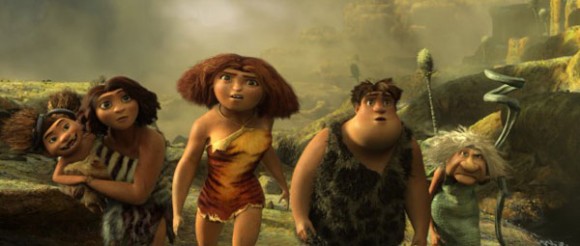 The story centers on the eldest daughter of the family, Eep, a teenage cavegirl who longs for more than the cautious, safe life her family has planned for her. Or does it? An argument could also be made that the film’s protagonist is Eep’s father, Grug, a traditional prehistoric man who has to make a few sacrifices if he wants his family to be both safe and happy. Or…should we be rooting for Guy? He’s a more evolved man-on-a-mission who meets the Croods for the first time and provides the audience a window into the offbeat family.
The story centers on the eldest daughter of the family, Eep, a teenage cavegirl who longs for more than the cautious, safe life her family has planned for her. Or does it? An argument could also be made that the film’s protagonist is Eep’s father, Grug, a traditional prehistoric man who has to make a few sacrifices if he wants his family to be both safe and happy. Or…should we be rooting for Guy? He’s a more evolved man-on-a-mission who meets the Croods for the first time and provides the audience a window into the offbeat family.
Well, the answer is all of the above; “There’s a triangular interplay between Grug, his daughter Eep and Guy,” says Sanders. “Grug leads it off; he’s the first character you see, so he’s going to take the lead. But after that, it’s a little game where Eep and Grug and Guy all toss the scenes back and forth between each other. [It’s] an utterly unique relationship in any animated film I’ve ever worked on and really ever seen, and for that reason, I think, it’s also a very, very relatable story.”
While the film revolves around these three principals, it still manages to deftly service the connections between the rest of the cast, back and forth from father-daughter, mother-son, husband-wife, brother-sister. “You’re constantly adjusting those dials of making sure that everyone has a perspective,” says DeMicco, “but you’re still carrying through a POV of a larger narrative.”
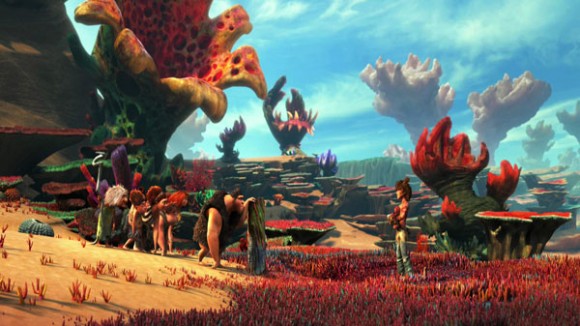 “Villains are very helpful when you’re writing,” says DeMicco. “It’s a lot harder when you have nothing to cut to. You have to make the A-story work because you’ve got no B-story.”
“Villains are very helpful when you’re writing,” says DeMicco. “It’s a lot harder when you have nothing to cut to. You have to make the A-story work because you’ve got no B-story.”
To keep the cast likeable, careful consideration went into casting and character motivation. Equally important was the development of their surroundings, which is a familiar-yet-fantastic world designed to surprise both the Croods and the audience. “Since the journey was one of a relationship, where they went physically was really up for grabs,” says Sanders. “We were looking for fresh new environments to challenge the Croods—to put them through ordeals that were designed to open their minds to a different aspect of life. Of all the films we ever worked on, more ideas came in from the other artists, not just from animators, but from our designers, our production designers, our art director. So, if somebody on the team created an environment that we felt was viable, we would write towards that one thing.”
What resulted was a lot of smart ideas and happy accidents that inspired their vision of the film further than they had originally anticipated. “We were incredibly stirred by the image of the caveman whose arms envelope the entire family. It was painted by one of our artists Margaret Wuller,” says DeMicco, referring to a drawing Grug paints on a cave wall in the film’s third act. “We just simply asked her to come up with some family-type icons that would go inside the cave. That was one of the ones that she showed us, and we both looked at each other and thought, ‘Omigosh, this is more than what we’ve asked for.’”
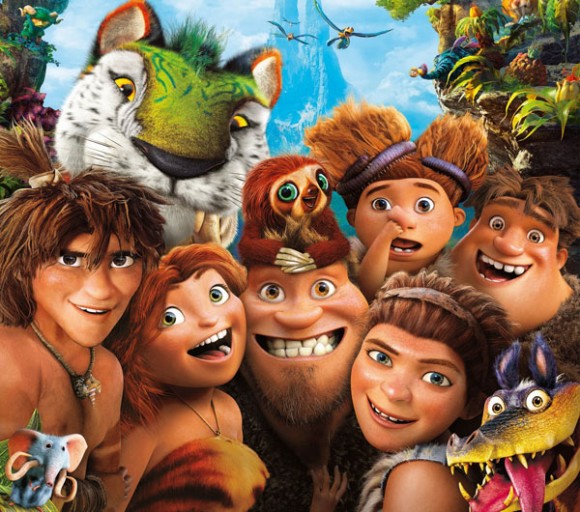 With plenty of ideas to choose from, the two directors had the difficult task of choosing the ones that best serviced the story they were trying to tell. “There was a lot of material we had to discard along the way,” says Sanders. And as they have just recently began to shape the story for a sequel, they’re planning on going back and putting some of those discarded ideas to good use. “There’s a half dozen things, at least, that we may pull out and use because we didn’t have time in the first film.” And considering that familial dynamics are in a neverending process of evolution, there’s still a lot for them to focus on. “There’s other characters to explore,” DeMicco says, “there’s other relationships in a family that we can really dig into.”
With plenty of ideas to choose from, the two directors had the difficult task of choosing the ones that best serviced the story they were trying to tell. “There was a lot of material we had to discard along the way,” says Sanders. And as they have just recently began to shape the story for a sequel, they’re planning on going back and putting some of those discarded ideas to good use. “There’s a half dozen things, at least, that we may pull out and use because we didn’t have time in the first film.” And considering that familial dynamics are in a neverending process of evolution, there’s still a lot for them to focus on. “There’s other characters to explore,” DeMicco says, “there’s other relationships in a family that we can really dig into.”

.png)